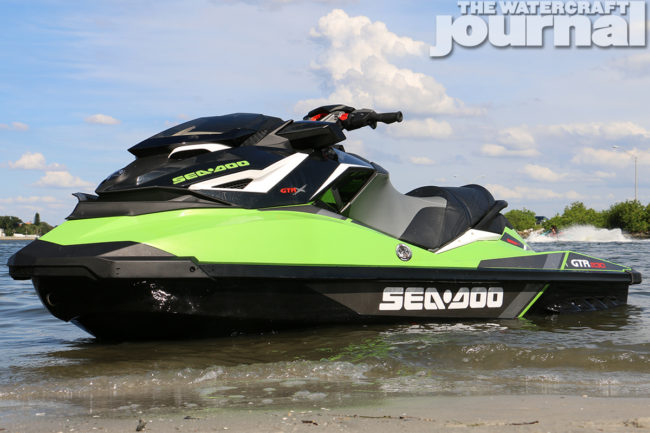
Having lived with the same 2017 Sea-Doo GTR-X 230 for nearly a year, it’s difficult to step back and permit oneself to opine about a machine that has been the subject of so many different mediums; when first introduced, The Watercraft Journal provided the industry’s first full-length feature review of the unit. Later, when a model was provided to us for long term testing, we developed quite a few articles about the vehicle, including being the subject of several touring episodes of our bimonthly YouTube show “Long Haul.” Truly, the GTR-X 230 has been an oft repeated topic in this publication, and we are sad to say that it will be leaving our stable and returning home (to be replaced by one of its newer, shiner and 300-horsepower siblings). Yet today, we must provide our findings after 10-long months of pleasure riding, cruising, long distance touring, and the occasional on-the-fly drag race.
Originally destined as a market segment filler for the performance-minded enthusiast looking for all of the race-inspired ergonomics yet without the love it-or-hate it hard handling T3 hull of the RXP-X, the GTR-X 230 shares its powertrain with its less ornate GTR 230 counterpart, and like the two, the same 130.6-inch long SMC fiberglass hull shaped and formed for the entire Recreation segment (GTI, GTI SE and GTI Limited). The shallow-V configuration, gentle strakes and sweeping chines give the GTI/GTR hull a comfortable straight-line track, reliable grip in a listing hairpin and just enough looseness that the tail can be snapped free, and fishtailed when appropriately throttled. We stray from using adjectives like “loose” or “squirrelly” as it denotes thoughts of instability and lack of control, but such is not the case. We pushed the GTR-X 230 hard through a variety of cornering, and when trimmed right and positioned correctly, the GTR-X bites down hard and peels a corner with aplomb.

When introduced for the 2017 lineup, the GTR-X 230 was also the solitary Sea-Doo to feature the brand’s then-innovative CM-Tech material. Standing for “Close Mold Technology,” the name describes how rather than applying a gel coat to the mold before injection, Sea-Doo applies multi-layer thermoformed sheets of Acrylic and ABS into the mold before the fiberglass is injected. This, according to Sea-Doo Watercraft Global Product Manager James Heintz, “accelerates the process and also improves quality thus reducing the number of rejects. In effect, this creates a high gloss acrylic finish on the top deck that is more resistant to chipping and cracking due to the flexible nature of the acrylic sheets. In addition, the inside of the deck is now smooth, with no protruding sharp pieces of epoxy or fiberglass matting.”
The subtle opalescence in the California Green Metallic is subtle at first, and really only appears when bathed in sunlight, revealing a pearled shimmer from deep within. Inside of the deck, the surface is smooth, free of tangled fibers or sharp throngs to snag skin or clothing. We noted the surface is somewhat chalky and can be scraped with a fingernail, reminding one of raw drywall. Of course, CM-Tech is perfectly repairable with traditional fiberglass kits requiring no proprietary materials in case of an accident, which is a good thing considering that all of the new ST3-based runabouts (RXT, RXT-X 300, GTX, GTX Limited 230/300) are all made from the new substance – both hull and deck. Attributes to CM-Tech include greater flex, strength and durability too, making it a win-win for the brand altogether.


As with all 230-horsepower models, the GTR-X employs the same 159mm pump and the USCG-awarded second generation iBR, which is both more compact and lighter (weighing approximately 16.4-poounds, including the electronic module and all of the mechanical components) than the previous iteration, but also stops the craft nearly 160-feet sooner than before. And, thanks to BRP’s iControl engine management, the GTR-X 230 has been optimized for regular fuel, although it is still strongly recommend feeding the GTR-X 230 premium fuel if performance is what you’re looking for. All of this not only makes the GTR-X 230, as Heintz states, “faster and more powerful than its predecessor, but just as fuel efficient.” Of which, fuel capacity remains identical to its GTI/GTR brethren at 15.9 gallons, and storage is on par with the RXP-X rather than the GTR (at 30.7 gallons versus 30.8 due to the differing glove box designs).
Of course, when introduced, the GTR-X 230 was one of the first to feature an all-new 1,494cc in-line three cylinder “1500 HO ACE” powerplant, replacing the 1503 215-horsepower Rotax 4-tec. Using the previous engine’s crankcase and cylinder case castings, the 1500 HO benefits from the redesigned cylinder head sporting four valves-per-cylinder, an all-new combustion chamber, improved intake and exhaust ports – all making for superior quench and distribution – as well as the new sleeveless cylinder coatings. The 1500 HO uses a new plasma coating applied via a proprietary thermal spraying process exclusively developed by Rotax’s team in Gunskirchen, Austria, to replace the heavy steel pressed-in sleeves. This not only shaves overall engine weight (totaling 194-pounds), but improves surface durability and heat transference by minimizing friction. Add to that Sea-Doo’s new maintenance-free supercharger and external intercooler, and the 1500 HO ACE shines.


In our year’s test, we tallied a total 38 hours of riding. This to many may be a paltry sum, but considering how much riding we do on other units throughout the year, was quite a bit. The GTR-X 230 was our steed for several adventure rides where fuel consumption was key to our survival. To our surprise, our fuel consumption rate was equal to that of several naturally-aspirated Yamahas ballyhooed for their mileage; toggling between Touring and Eco Mode made this achievement possible. When called upon, the GTR-X happily leapt to action, as Sport Mode was enabled. As recorded via GPS, we clicked a respectable (and consistent) 68.8mph maximum speed when unladen with storage or excessive fuel (a number equal to Sea-Doo’s 300-horsepower machines).
On longer rides, we equipped our sporty GTR-X with a Kool PWC Rack replete with twin RotoPax cans adding an additional 6 gallons of fuel and a large cooler filled with provisions. Even with the extra cargo, and the VTS trim nosing the ski down a notch or two, the runabout performed almost ignorant of its extra weight over the transom. At one point, we burdened the Sea-Doo with an extra rider’s worth of weight (nearing 180 extra pounds); and with that and two passengers pushed the craft close to its maximum occupancy constraints. Nevertheless, the GTR-X 230 never failed. In fact, over our sojourn with this machine, we only found minor aesthetic issues to quibble about – primarily fit-and-finish issues with the fairing around the gauge cluster separating, dirt/mold collecting beneath the clear plastic hood shield, and some discoloring on the glossy plastic portions of the hood and top deck that even BRP’s own cleaners and polishes couldn’t amend.


In all, the 2017 Sea-Doo GTR-X 230 performed far better than we had expected for a performance-bred machine. At the time of its release, the the 2017 Sea-Doo GTR-X 230 and its performance-minded X-Package tacked on an additional $1,000 over its more subdued 2017 GTR 230 compatriot, raising its MSRP at $12,999. Today, the 2018 is $13,099, as it includes the telescoping steering neck first found on last year’s Spark Trixx. As we surmised in our first report, the GTR-X is truly a high-speed go-kart that can be enjoyed by all members of the family. Admittedly, we used the GTR-X 230 for tasks far beyond its intent, and for that cause we’re equally (if not more so) pleased with this machine. Again, this is the last of a procession of features and videos on our trustworthy 2017 Sea-Doo GTR-X 230. Thankfully, all of this supersaturation has paid dividends; commenters on several “Long Haul” videos have confirmed buyers taking our suggestion resulting the sales of a handful of GTX-R 230’s directly in response to our efforts.

























thank you so much bro?
?
thanks man?